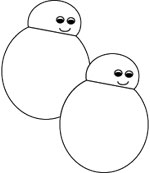|
Included in the books listed below are several fantasy books
involving bubbles appropriate for younger students. There is a
question-answer type book focused on questions about bubbles,
soap, water, and other bath-related topics. Several other books
focus on the mathematical topics of measurement (using both standard
and non-standard measuring tools), volume, and topology, and on
the topic of color, all of which relate to the activities
in Bubble Festival. Don’t miss The Wise Woman and Her Secret,
a great book for preparing students for the activities in Bubble
Festival. This book shows the power of curiosity, asking questions,
and making careful observations.
Anno’s Math Games III
Bubble Bubble
Hailstones and Halibut Bones: Adventures in Color
How Big Is A Foot?
The Magic Bubble Trip
Monster Bubbles
Mr. Archimedes’ Bath
Rubber Bands, Baseballs and Doughnuts: A
Book about Topology
Splash! All About Baths
The Wise Woman and Her Secret
Anno’s Math Games III
by Mitsumasa Anno
Philomel Books/Putnam & Grosset, New York. 1991
Grades: 2–5
Picture puzzles, games, and simple activities introduce mathematical
concepts and invite active participation. Measurement activities
relate to the “Bubble Measurement” activity.
Return to title list.
Bubble Bubble
by Mercer Mayer
Parents’ Magazine Press, New York. 1973
Rainbird Books/Publishers Group West, Emeryville, California.
1991
Grades: Preschool–2
A little boy buys a magic bubble maker and creates and controls
bubbles in the shapes of animals. The animals are progressively
larger and more scary, so they appear to chase each other away.
Watch for the surprise ending!
Return to title list.
Hailstones and Halibut Bones:
Adventures in Color
by Mary O’Neill; illustrated by John Wallner
Doubleday, New York. 1961, 1989
Grades: All
In 12 two-page poems the author presents her impression of
various colors. Her perceptions go far beyond visual descriptions,
painting a full spectrum of images. Good extension to the “Bubble
Colors” activity.
Return to title list.
How Big Is A Foot?
by Rolf Myller
Dell/Bantam, New York. 1962, 1990
Grades: K–5
When the king asks the apprentice carpenter to build the queen
a bed for her birthday, he readily agrees and asks for the measurements.
The king obliges and measures her bed using his feet. Somehow
the bed that gets made is much smaller. This delightful story
clearly shows the need for a standard unit of measurement. Good
extension to the “Bubble Measurement” activity.
Return to title list.
The Magic Bubble Trip
by Ingrid & Dieter Schubert
Kane/Miller Book Publishers, New York. 1981
Grades: K–3
James blows a giant bubble that carries him away to a land
of large hairy frogs where he has a fun, fanciful adventure.
Return to title list.
Monster Bubbles
by Dennis Nolan
Prentice-Hall, Englewood Cliffs, New Jersey. 1976
Out of print
Grades: Preschool–1
Various monsters take turns blowing bubbles in amounts from
one to twenty. This simple, wordless book is a fun counting book
for the youngest students.
Return to title list.
Mr. Archimedes’ Bath
by Pamela Allen
HarperCollins, New York. 1980
Grades: K–2
Upset by his bath overflowing and puzzled by the changing
water level, Mr. Archimedes first tries to blame one of his three
bath companions (a kangaroo, a goat, and a wombat). He then resorts
to scientific testing and measuring to find out about his bath.
Good connections to the measurement activities in this guide,
and to questions about volume and density.
Return to title list.
Rubber Bands, Baseballs and Doughnuts:
A Book about Topology
by Robert Froman; illustrated by Harvey Weiss
Thomas Y. Crowell, New York. 1972
Out of print
Grades: 4–10
An introduction to the world of topology through active reader
participation. Topics can be related to the behavior of soap film
in the bubble skeletons, walls, and windows activities.
Return to title list.
Splash! All About Baths
by Susan K. Buxbaum and Rita G. Gelman.; illustrated by Maryann
Cocca-Leffler
Little, Brown, and Co., Boston. 1987
Grades: K–6
Before he bathes, Penguin answers his animal friends’ questions
about baths such as, “What shape is water?” “Why
do soap and water make you clean?” “What is a bubble?”
“Why does the water go up when you get in?” “Why
do some things float and others sink?” and many other questions.
Answers to questions are both clear and simple. Received the American
Institute of Physics Science Writing Award.
Return to title list.
The Wise Woman and Her Secret
by Eve Merriam; illustrated by Linda Graves
Simon & Schuster, New York. 1991
Grades: K–3
A wise woman who lives in the hills past the hollow is sought
out by many people for her wisdom. They look for her secret in
her barn and her house, but only little Jenny who lags and lingers
and loiters and wanders finds it. As the wise woman tells her,
“The secret of wisdom is to be curious—to take the time
to look closely, to use all your senses to see and touch and taste
and smell and hear. To keep on wandering and wondering.”
Great way to prepare your students for the experience of Bubble
Festival by emphasizing and valuing the role of curiosity, asking
questions, and using all the senses when gathering data. For the
teacher, this book also provides a nice sense of the “discovery”
element essential to hands-on science.
Return to title list.
|

|

